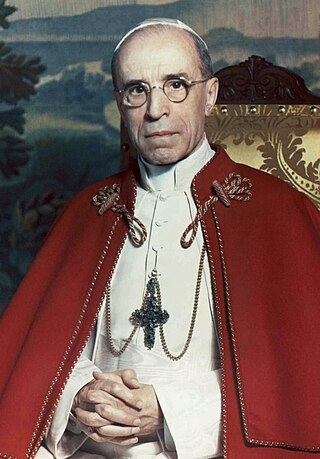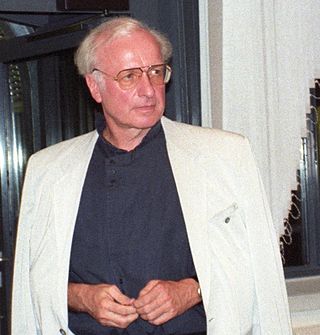Related Research Articles

Pope John Paul II was head of the Catholic Church and sovereign of the Vatican City State from 1978 until his death in 2005.

Pope Pius XII was head of the Catholic Church and sovereign of the Vatican City State from 2 March 1939 until his death in October 1958. Before his election to the papacy, he served as secretary of the Department of Extraordinary Ecclesiastical Affairs, papal nuncio to Germany, and Cardinal Secretary of State, in which capacity he worked to conclude treaties with various European and Latin American nations, including the Reichskonkordat treaty with the German Reich.

Elio Toaff was the Chief Rabbi of Rome from 1951 to 2002. He served as a rabbi in Venice from 1947, and in 1951 became the Chief Rabbi of Rome.
The Catholic Church and Judaism have a long and complex history of cooperation and conflict, and have had a strained relationship throughout history, with periods of persecution, violence and discrimination directed towards Jews by Christians, particularly during the Middle Ages.

Gerd Albrecht was a German conductor.

Sir Gilbert Levine, GCSG is an American conductor. He is considered an "outstanding personality in the world of international music television." He has led the PBS concert debuts of the Staatskapelle Dresden, Royal Philharmonic, London Philharmonic, Philharmonia Orchestra, WDR Symphony Orchestra, and the Pittsburgh Symphony, and the PBS premieres of works including the Beethoven Missa Solemnis, Bach Magnificat in D, Haydn Creation, and Bruckner Symphony 9.

Pietro Palazzini was an Italian cardinal, who helped to save the lives of Jewish people in World War II. He was consecrated bishop by the pope in 1962 and was elevated to the cardinalate in 1973. He has been commemorated by Yad Vashem. From 1980 to 1988, Cardinal Palazzini was Prefect of the Congregation for the Causes of Saints.
This is an index of Vatican City–related topics.

Diplomatic relations between the Holy See and the State of Israel, as well as a concordat defining the status and fiscal and property rights of the Catholic Church and related entities within Israel. Formal diplomatic relations between the two states were established after the adoption of the Fundamental Agreement by the two States on 30 December 1993. A Vatican Nunciature in Israel and an Israeli embassy in Rome were simultaneously opened on 19 January 1994. From the Vatican's point of view, the establishment of diplomatic relations between the two states is part of the Christian–Jewish reconciliation; and from the Israeli point of view, the normalization of diplomatic relations. Prior to the establishment of diplomatic relations, the interests of the Catholic Church in Israel were looked after by the Apostolic Delegate to Jerusalem and Palestine, the Latin Patriarch of Jerusalem and the Custodian of the Holy Land, all of which continue to function.
We Remember: A Reflection on the Shoah is a document published in 1998 by the Catholic Commission for Religious Relations with the Jews, under the authority of Pope John Paul II. In this document the Vatican condemned Nazi genocide and called for repentance from Catholics who had failed to intercede to stop it. It urges Catholics to repent "of past errors and infidelities" and "renew the awareness of the Hebrew roots of their faith" while distinguishing between the Church's "anti-Judaism" as religious teaching and the murderous antisemitism of Nazi Germany which it described as having "roots outside Christianity."
The Cappella Giulia, officially the Reverend Musical Chapel Julia of the Sacrosanct Papal Basilica of Saint Peter in the Vatican, is the choir of St. Peter's Basilica that sings for all solemn functions of the Vatican Chapter, such as Holy Mass, Lauds, and Vespers, when these are not celebrated by the Pope. The choir has played an important role as an interpreter and a proponent of Gregorian chant and sacred polyphony.
The Commission for Religious Relations with the Jews is a pontifical commission in the Roman Curia tasked with maintaining positive theological ties with Jews and Judaism. Established on 22 October 1974, it works alongside the Pontifical Council for Promoting Christian Unity.
The relations between Pope Benedict XVI and Judaism remained fairly good, although concerns were raised by Jewish leaders over the political impact of Traditionalists in the Church during the papacy of Benedict.
Pope John Paul II worked to improve relations between the Roman Catholic Church and Judaism. He built solid ties with the Jewish community in the hope of promoting Christian–Jewish reconciliation.

The papacy of Pius XII began on 2 March 1939 and continued to 9 October 1958, covering the period of the Second World War and the Holocaust, during which millions of Jews were murdered by Adolf Hitler's Germany. Before becoming pope, Cardinal Pacelli served as a Vatican diplomat in Germany and as Vatican Secretary of State under Pius XI. His role during the Nazi period has been closely scrutinised and criticised. His supporters argue that Pius employed diplomacy to aid the victims of the Nazis during the war and, through directing his Church to provide discreet aid to Jews and others, saved hundreds of thousands of lives. Pius maintained links to the German Resistance, and shared intelligence with the Allies. His strongest public condemnation of genocide was, however, considered inadequate by the Allied Powers, while the Nazis viewed him as an Allied sympathizer who had dishonoured his policy of Vatican neutrality.
Pope Pius XII's response to the Roman razzia, or mass deportation of Jews, on October 16, 1943, is a significant issue relating to Pope Pius XII and the Holocaust. Under Mussolini, no policy of abduction of Jews had been implemented in Italy. Following the capitulation of Italy in 1943, Nazi forces invaded and occupied much of the country, and began deportations of Jews to extermination camps. Pius XII protested at diplomatic levels, while several thousand Jews found refuge in Catholic networks, institutions and homes across Italy, including in Vatican City and Pope Pius' Summer Residence. The Catholic Church and some historians have credited this rescue in large part to the direction of Pope Pius XII. However, historian Susan Zuccotti researched the matter in detail and states that there is "considerable evidence of papal disapproval of the hiding of Jews and other fugitives in Vatican properties."
Three Popes and the Jews is a 1967 book by Pinchas Lapide, a former Israeli Consul to Milan, who at the time of publication was a deputy editor in the Israeli Prime Minister's press office. The "three popes" are Pope Pius XII (1939–1958), Pope John XXIII (1958–1963), and Pope Paul VI (1963–1978).
The Papal Concert of Reconciliation was a historic musical event in the pontificate of Pope John Paul II. The concert took place in the Paul VI Auditorium at the Vatican on January 17, 2004, in the presence of the Pontiff, Rav Elio Toaff, the Emeritus Chief Rabbi of Rome, and Abdulawahab Hussein Gomaa, the Imam of the Mosque of Rome, and an audience of 7,000 invited guests. The concert also followed the first visit to the Vatican of Israel's two chief rabbis, both of whom attended the concert. It was conceived, created, and conducted by Sir Gilbert Levine, whose previous musical collaborations with the Pope, including the Papal Concert to Commemorate the Shoah in 1994 with the Royal Philharmonic Orchestra and the Concert for the Pope's 80th Birthday in 2000 with the Philharmonia Orchestra, among others, had earned him the sobriquet "The Pope's Maestro." In realizing the concert, Levine sought to fulfill the Pontiff's wish to reach out to the followers of the Abrahamic faiths, as part of the celebrations dedicated to the 25th anniversary of his pontificate.
During the Holocaust, the Catholic Church played a role in the rescue of hundreds of thousands of Jews from being murdered by the Nazis. Members of the Church, through lobbying of Axis officials, provision of false documents, and the hiding of people in monasteries, convents, schools, among families and the institutions of the Vatican itself, saved hundreds of thousands of Jews. The Israeli diplomat and historian Pinchas Lapide estimated the figure at between 700,000 and 860,000, although the figure is contested.
References
- ↑ Lee Moriwaki (1994-10-15). "Concert To Remember Holocaust Is Olive Branch From Pope To Jews". The Seattle Times. Retrieved 2024-08-12.
- 1 2 3 William D. Montalbano (1994-04-08). "Pope John Paul Attends First Vatican Concert That Memorializes Holocaust". Los Angeles Times. Retrieved 2024-08-12.
- ↑ "Photo of the Pope (in white) with some other men (in black)" (JPG). Retrieved 2024-06-21.
- ↑ Raab Kalina, Margit. Surviving a Thousand Deaths (1939-1945) in Stolen Youth: Five Women's Survival in the Holocaust. Yad Vashem & Holocaust Survivors Memoirs Project, 2005.
- ↑ "Discorso di Giovanni Paolo II al Termine del Concerto Eseguito in Commemorazione della "Shoah" Ebraica" (Press release). The Vatican/Holy See. 7 April 1994. Retrieved 2024-08-12.
- ↑ Levy, Alan (1996-01-31). "Storm at Czech Philharmonic". The New York Times. Retrieved 2020-04-29.
- ↑ Tagliabue, John (8 April 1994). "Holocaust Lamentations Echo at Vatican". The New York Times.
